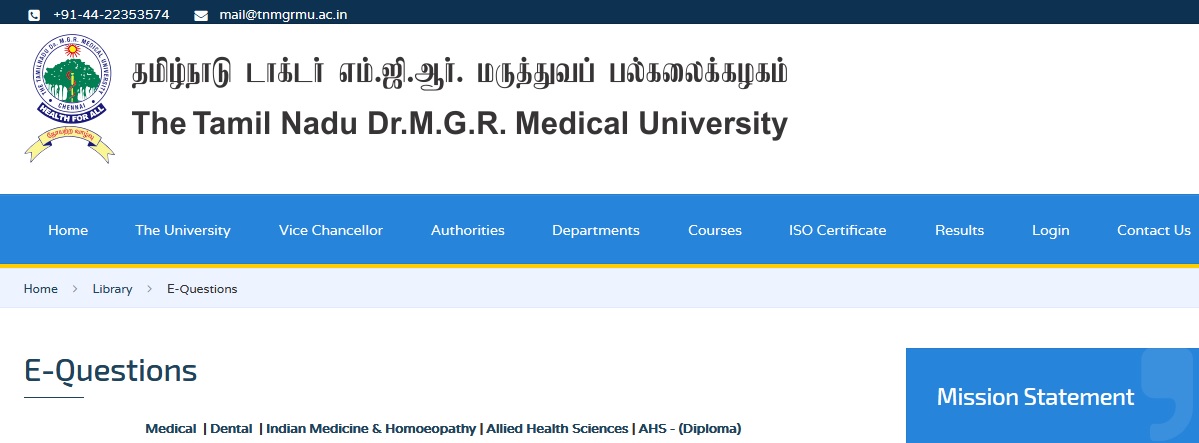Paediatrics including Neonatology MBBS Question Bank : web.tnmgrmu.ac.in
Name of the University : The Tamilnadu Dr. M.G.R. Medical University
Degree : Third M.B.B.S (Part-II)
Subject Code/Name : 4087 Paediatrics including Neonatology
Paper : VII
Document Type : Question Bank
Website : web.tnmgrmu.ac.in
Download Model/Sample Question Paper :
2008-2014 : https://www.pdfquestion.in/uploads/we…1-524087LA.pdf
2001-2008 : https://www.pdfquestion.in/uploads/we…E-524087KU.pdf
TN MGRMU Paediatrics Question Paper
August 2008 :
I. Essay Questions : (2 x 15 = 30)
Related : The Tamilnadu Dr. M.G.R. Medical University General Pharmacology, Experimental Pharmacology & Bioassay MD Question Bank : www.pdfquestion.in/4283.html
1. Describe the growth chart, uses of growth chart, in paediatric clinic and causes of growth failure.
2. What are the causes of proportionate dwarfism. Describe the features of endemic goitre investigations and treatment for the same.

II. Write Short notes on : (10 x 5 = 50)
1. Genetic Counselling.
2. Non Nutritional rickets.
3. Causes of convulsions in newborn period.
4. Causes of lactation failure.
5. Kangaroo mother care.
6. Breath holding spells.
7. Radiological assessment of age.
8. Peripheral smear in thalassemia.
9. Components of TOF.
10. Components of kartazenar’s syndrome.
III. Short Answer Questions : (10 x 2 = 20)
1. Vitamin ‘A’ prophylaxis.
2. Pseudotumor cerebri causes.
3. Components of primary complex.
4. Shake test.
5. Causes for preventable mental retardation.
6. Four complications of measles.
7. Treatment of pertusis.
8. Triple test in newborn screening.
9. USG findings of down’s syndrome antinatally.
10. Erythema Toxicorum.
February 2009
I. Essay Questions : (2 x 15 = 30)
1. Classify congenital heart diseases. Discuss the Hemodynamics, assessment of severity, its course and complications of ventricular septal defect.
2. Discuss CSF circulation. What are the common causes of Hydrocephalus, also discuss about the diagnosis and treatment of Hydrocephalus.
II. Write Short notes on : (10 x 5 = 50)
1. Phenobarbitone in Pediatric Practice.
2. Hormonal influence on growth.
3. Hypokalemia in children and its management.
4. Baby friendly Hospital initiative.
5. Pseudotumor Cerebri.
6. Non Shivering Thermogenesis
7. Eradication of Poliomyelitis.
8. Common Metabolic Neuropathies.
9. Scabies.
10. Platelet Transfusion.
III. Short Answer Questions : (10 x 2 = 20)
1. Four Preventable causes of Mental Retardation.
2. Four Essential Feature of Kwashiorkar.
3. Four Minor Physiological problems in neonate.
4. Four common causes of persistent diarrhea.
5. Four common Skin problems in Paediatrics.
6. Four factors that can lessen breast Milk production.
7. Four newer Vaccines.
8. Four clinical features of Acute Glomerulonephritis.
9. Four clinical features of Hypothyroidisim
10. Four complications of Diphtheria.
February 2010
I. Essay Questions : (2 x 15 = 30)
1. List the common causes of pyrexia of unknown origin in children. Briefly indicate the investigations for a child with prolonged fever more than two weeks. Discuss the specific treatment for six year old child with falciparum malaria.
2. Define failure to thrive in children. List the investigations for a six month old baby with failure to thrive. Indicate how to treat a nine month old baby with failure to thrive due to faulty feeding technique.
II. Write Short notes on : (10 x 5 = 50)
1. Differences between Kwashiorkar and marasmus.
2. Zinc deficiency in children.
3. Measles mumps rubella (MMR) vaccine.
4. Rheumatic fever prophylaxis.
5. Diagnosis of tuberculous meningitis.
6. Management of febrile fits.
7. APGAR score.
8. Baby friendly hospital Initiative.
9. Pediatric HIV infection.
10. Atypical pneumonia in children.
III. Short Answer Questions : (10 x 2 = 20)
1. Oral rehydration therapy corner.
2. Peripheral smear in iron deficiency anemia.
3. Stepwise management of bronchial asthma.
4. Indications for intravenous immunoglobulins in children.
5. Juvenile rheumatoid arthritis.
6. Differences between cyanotic spell and breath holding spell.
7. Features of viper envenomation.
8. Causes of respiratory distress in new born.
9. Differences between physiological and pathological jaundice in new born.
10. Caput succedaneum.
August 2010
I. Essay Questions : (2 x 15 = 30)
1. Define Preterm. Enumerate the causes of Preterm. What are the principles in the management of preterm baby?
2. Define Nephrotic syndrome. Write in detail laboratory diagnosis and management of minimal change nephrotic syndrome.
II. Write Short notes on : (10 x 5 = 50)
1. Infant mortality rate.
2. Steps for successful breast feeding.
3. Aetiology of neonatal sepsis.
4. Kangaroo care.
5. Hypothermia of new born.
6. Pneumococcal vaccine.
7. Treatment of acute bronchiolitis.
8. Management of congestive cardiac failure.
9. Oral Rehydration Solution (ORS).
10. Complication of measles.
III. Short Answer Questions : (10 x 2 = 20)
1. Neonatal screening for hypothyroidism.
2. Principles of Phototherapy.
3. Vitamin ‘A’ Prophylaxis.
4. Treatment of Nutritional Rickets.
5. Umbilical cord care.
6. Peripheral blood picture in Thalassemia major.
7. Treatment of Streptococcal Pharyngitis.
8. Four common causes of fever with rash.
9. What are the four types of shock?
10. What are the two key signs of dehydration?
February 2011
I. Essay Questions : (2 x 15 = 30)
1. Write an essay on etiology, complications and management of preterm baby.
2. 2 years old female child weighing 8.2 kgs brought to the Health centre with the complaints of vomiting and diarrhea. How will you approach the child. Write the management in detail.
II. Write Short notes on : (10 x 5 = 50)
1. Jaundice in New born
2. ICDS
3. Growth chart
4. Breast feeding advantages
5. Pneumonia
6. SAM
7. Rheumatic fever
8. Adverse events following Immunization
9. ORS
10. Antenatal Diagnosis
III. Short Answer Questions (15 x 2 = 30)
1. Hypoglycemia.
2. LGA.
3. Caput.
4. Vit K in newborn.
5. Kangaroo care.
6. BFHI.
7. Newer vaccines.
8. Vitamin – A.
9. Diagnosis of Leptospirosis.
10. Contraindication to Bag and Mask ventilation.
11. Definition of Nephrotic Syndrome.
12. Common organisms causing meningitis.
13. Types of VSD.
14. Etiology of Cirrhosis.
15. Use of Ivermectin.